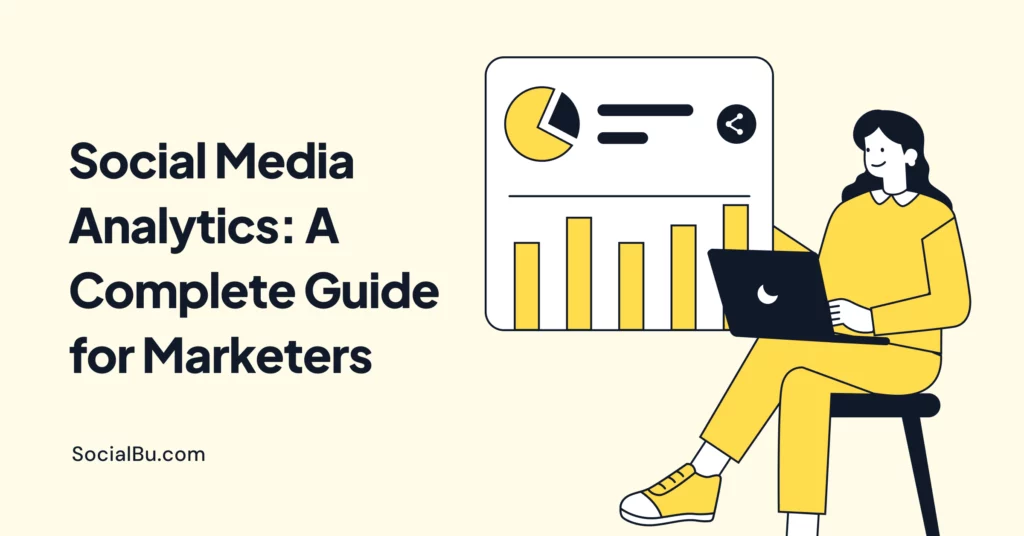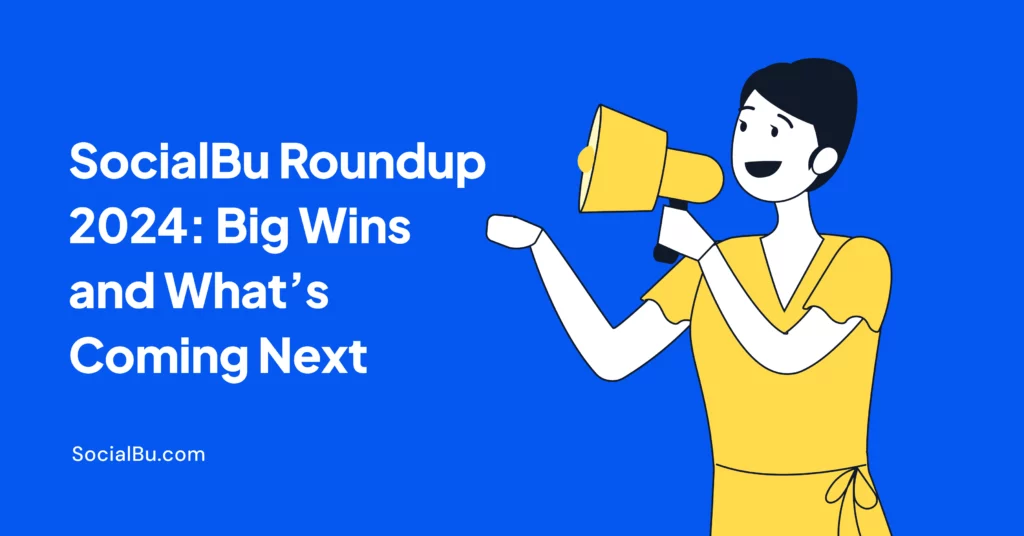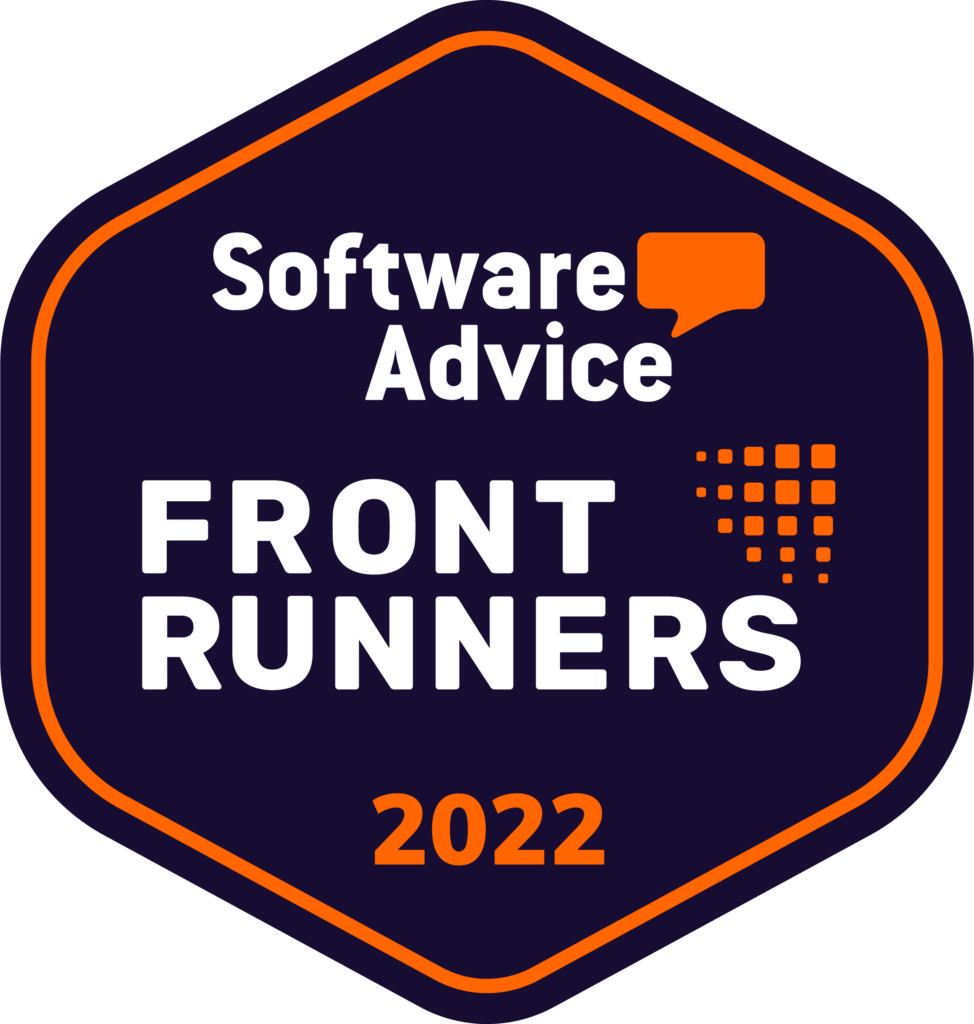Creating content is easy. But what about proving its impact to your client or stakeholder? That’s where most marketers and agencies struggle. Without a clear system for tracking performance, it’s challenging to determine what works, what doesn’t, and where to make improvements. Social media analytics make this tracking easier.
They transform raw numbers into actionable insights, enabling you to track progress, optimize campaigns, and demonstrate tangible ROI.
In this comprehensive guide, we’re going to cover
- Must-track social media metrics
- How to use social media analytics effectively
- Top social media analytics tools
- How to set up a social media analytics dashboard
- Proven strategy tips
So, be prepared to discover how, as an agency owner and marketer, you can analyze, automate, and act on your social media data more efficiently.
Let’s get started.
What is Social Media Analytics?
Social media analytics is the process of collecting, tracking, and analyzing data from social media platforms. But for what purpose? It’s to evaluate the performance of your content, social media campaigns, and overall social media strategy.
Here is what a social media analytics dashboard helps marketers and agencies gain the clarity to:

As a marketer, you can utilize the features of social media analytics tools to measure key metrics. After that, you make data-informed decisions about how to transform your business’s marketing efforts, guide your social media strategy, and prove ROI.
Unlike basic social media monitoring, which only tracks mentions and keywords in real time, social media analytics looks deeper. It focuses on patterns, trends, and performance over time, helping you deliver meaningful social media insights that inform future planning and decision-making.
Relying on solid social media data analysis helps remove assumptions and replace them with evidence.
With social media analytics metrics, you get a clearer picture of your audience’s behavior, content performance, and campaign impact—all in one place.
Why Social Media Analytics Matter for Marketers and Agencies
We understand that, being an agency owner, you handle more than one brand or manage multiple clients. So, you can no longer rely on assumptions and guesswork, as they lead to poor results.
You need data.
Social media analytics for marketers provides you with reliable data.
Let’s look in detail at the importance of social media analytics reporting for marketers and agency holders:
1. Understand Your Results, Clearly
Not every high-level post contributes to your business goals. Social media analytics tools help you move beyond vanity metrics and focus on content that delivers results.
A good social media analytics strategy allows you to:
- Track key performance indicators like impressions, CTR, engagement rate, and conversions
- Measure success by platform, campaign, or content type
- Understand the role of each channel in your funnel
- Compare current metrics with past benchmarks for deeper social media measurement
This helps refine both your content and timing.
2. Know Your Audience Better
Understanding your audience is essential to effective messaging and creating relevant content.
With social media analytics, you get detailed social media insights into:
- Audience demographics such as age, location, and interests
- Engagement trends over time
- Which content types resonate most
These insights enable better social media optimization, more targeted messaging, and more relevant content.
3. Spot Trends Early
With proper social media tracking, you can identify rising trends before your competitors do. From viral content formats to trending hashtags and emerging topics, analytics reveals what’s gaining attention so that you can act fast.
This is especially valuable for agencies aiming to show proactive value to clients.
4. Make Data-Driven Campaign Decisions
Launching a new campaign based on instinct is risky. Social media analytics platforms help you make decisions based on the data from your previous strategy.
You’ll be able to:
- A/B test content with measurable outcomes
- Focus on channels and formats that drive ROI
- Align campaigns with performance goals
This is where social media intelligence supports smarter execution.
5. Maximize Your Paid Media ROI
When investing in paid ads, every dollar counts. Social media analytics for agencies is essential for managing and optimizing ad spend.
Use analytics to:
- Test creatives and adjust in real-time
- Reduce the cost per acquisition
- Improve overall social media ROI
To track the impact of your campaigns accurately, use this ROI formula:
ROI = (Net Profit on Investment/ Cost of Investment) * 100.
Since social ads are rarely the only touchpoint, attribution models help you assign credit accurately across the customer journey:
| Model | Use Case |
|---|---|
| First-Click | Good for awareness-focused TikTok ads |
| Last-Click | Useful for retargeting or final conversion clicks |
| Linear | Great when multiple touchpoints (TikTok, email, landing page) are used |
| Time Decay | Prioritizes recent interactions leading to conversion |
| Position-Based | Balances credit between first and last clicks (ideal for full-funnel) |
For accurate ROI tracking, use tools like SocialBu with UTM tracking, or integrate TikTok ad data with Google Analytics and your CRM.
7. Prove Your Value with Clear Reports
Clients and stakeholders don’t want fluff—they want results. So, whether you’re an in-house marketer or part of an agency, your success needs to be seen. Social media analytics reporting enables you to demonstrate your impact.
Use platforms like SocialBu that offer downloadable, visual reports that:
- Highlight key wins
- Show consistent performance growth
- Align with client or stakeholder goals
This adds credibility and supports stronger relationships with your clients.
Types of Social Media Analytics You Need to Track
There are various types of social media analytics, and understanding which analytics types to monitor is crucial for building a strong social media strategy. As a marketer or agency, you must move beyond basic metrics to gain deeper, actionable insights into social media.
Here are the most crucial types of social media analytics to track for a measurable return on investment (ROI), enabling you to improve your social media performance.
1. Performance Analysis
Performance analysis is the foundation of any social media analytics strategy. It helps you measure how your content performs over time using key social media metrics and key performance indicators (KPIs).
Track essential social media metrics like:
- Reach
- Impressions
- Follower growth
- Likes
- Shares
- Comments
- Views
- Conversion rate
You can use a powerful social media analytics dashboard to view real-time insights, benchmark results, and identify what content delivers the most value.
Example: If your Instagram Reels are consistently outperforming static posts in engagement, your social media data analysis will reveal this pattern. And it’s a sign to focus more on video content.
SocialBu’s Analyze feature helps marketers track performance across platforms and provide transparent social media reporting that highlights both strengths and areas for improvement.
2. Audience Analytics
Audience analytics gives you a closer look at who engages with your content. This includes demographic and behavioral data that helps shape content decisions and improve targeting.
Track:
- Age, gender, and location breakdowns
- Peak activity times
- Follower growth and churn rates
- Preferred content formats
These social media analytics for marketers reveal what resonates with different audience segments, allowing for better social media optimization and campaign personalization.
Example: A B2B SaaS agency discovers through analytics that 70% of their LinkedIn audience is from the US, aged 30–45. They use this to create region-specific posts that improve social media engagement metrics.
3. Competitor Analysis
Social media analytics for agencies isn’t complete without understanding what competitors are doing. Through competitor analysis, you can benchmark your performance, identify gaps, and refine your strategy.
Track metrics like:
- Posting frequency
- Engagement rates
- Top-performing content types
- Follower growth trends
This data supports stronger social media benchmarking, enabling your brand or clients to stay ahead in a competitive space.
4. Paid Social Analytics
Investing in social ads? You need solid social media data analysis to track ROI and campaign efficiency.
Focus on the following paid KPIs:
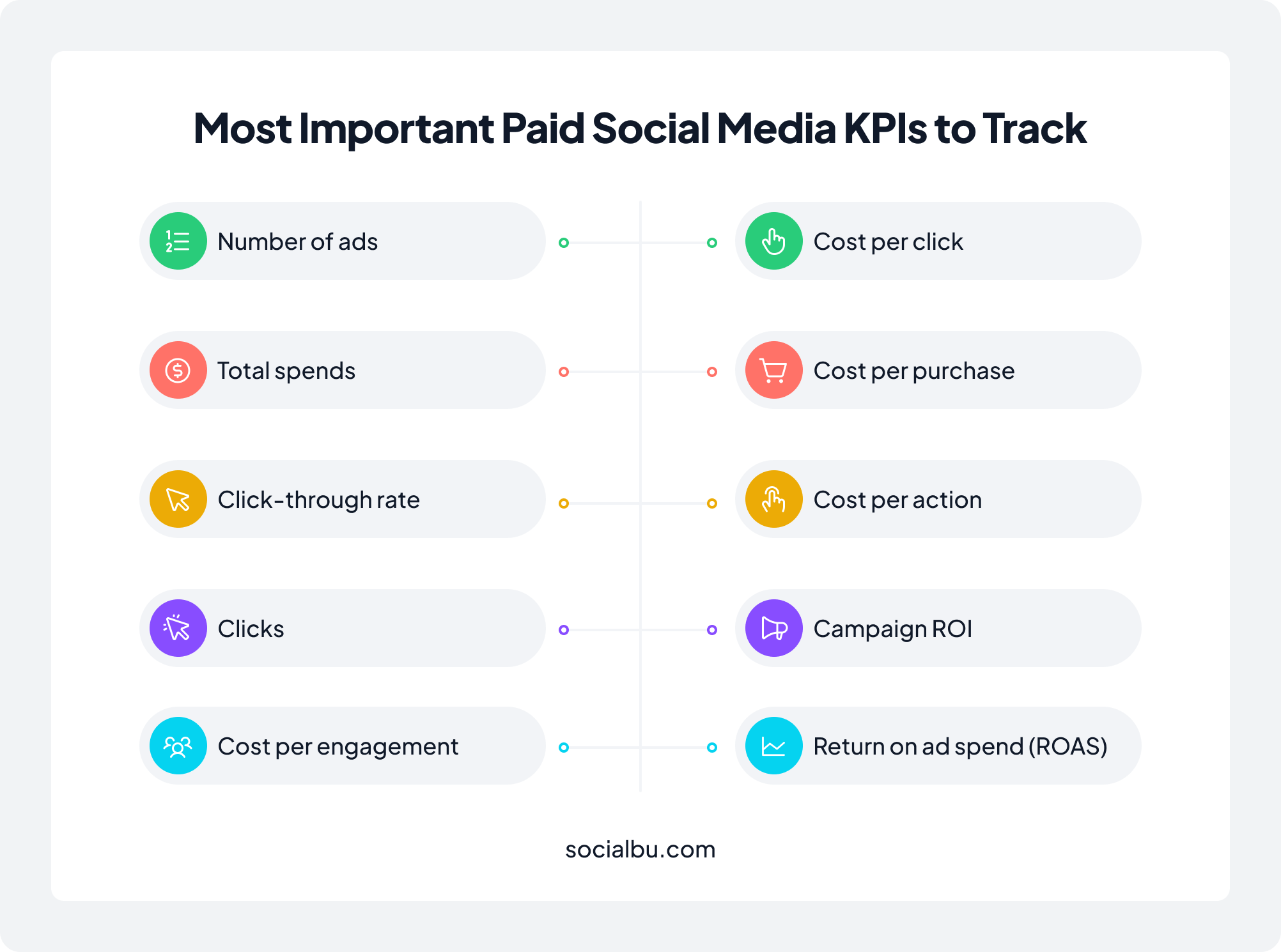
With accurate social media analytics reporting, you can adjust targeting, creatives, and budgets in real-time. SocialBu helps marketers monitor these paid efforts in one centralized social media analytics dashboard.
5. Cohort Analysis
Want to understand how different groups of followers behave over time? Cohort analysis helps you do just that.
Track:
- Follower groups based on join date or interaction type
- Engagement over time by each cohort
- Retention and repeat interaction per cohort
- Cohort-based conversion rates
- Post types that resonate with specific audience segments
This helps you refine targeting and content strategies by learning what works best for each audience group.
6. Sentiment Analysis
Understanding how people feel about your brand matters. Sentiment analysis utilizes machine learning or artificial intelligence to identify the tone—positive, neutral, or negative—behind comments, mentions, and messages.
Use sentiment data to:
- Track brand reputation
- Respond proactively to negative mentions
- Celebrate wins with positive feedback
Combined with social media monitoring, this provides a comprehensive view of audience perception.
7. Predictive Analytics
Go from reactive to proactive. Predictive analytics helps forecast performance and engagement before you even hit “publish.”
Track:
- Projected engagement and reach of future posts
- Predicted best times to post
- Likelihood of audience growth based on recent trends
- Potential top-performing content formats
- Drop-off points in user journeys or funnels
Predictive analytics helps you plan ahead and post smarter based on data-driven forecasts, giving you a competitive edge.
7. Social Listening
Social listening enables brands to track broader conversations across the web, even those not tagged.
With it, you can:
- Discover trending topics
- Identify brand mentions and industry shifts
- Uncover user pain points and feedback
Social listening supports social media intelligence, enabling you to stay proactive rather than reactive.
Example: If SocialBu finds that people or the audience are discussing its new feature on Reddit. The marketing team jumps into the conversation, addressing questions directly about the product, new features, and how it can solve their problem, thereby boosting visibility and trust.
Social listening strengthens your overall social media analytics strategy and supports proactive engagement.
8. Community Management Analytics
This social media analytics focuses on how effectively you engage with your audience in real-time through replies, comments, direct messages (DMs), and mentions. These interactions foster trust, enhance brand loyalty, and shape how people perceive your brand online.
All of this is important because 52% of customers expect online brands to respond to their queries, messages, or reviews within one hour of posting.
So, for marketers and agencies, tracking this data helps you measure and improve your team’s responsiveness and interaction quality.
Key community management metrics include:
- Response time to comments and messages
- Response rate (percentage of messages replied to)
- Comment sentiment (positive, negative, neutral)
- Engagement volume by platform
10. Statistical Significance Testing
Not every bump in engagement indicates that your content strategy has been successful. Use this to validate real performance shifts.
Track:
- A/B test results (e.g., captions, posting times)
- Significance of performance differences between post types
- Conversion impact of experimental formats
- Engagement trends before and after changes
- Audience behavior patterns across variations
This enables you to make informed, data-driven content decisions instead of relying on assumptions.
Each of these analytics types plays a role in shaping better campaigns, supporting smarter strategy, and justifying your social media investments. Together, they form the backbone of a strong social media analytics strategy.
What are the Best Social Media Analytics Tools?
There are so many options available when it comes to social media analytics tools. And even every social media platform offers its native analytics.
But what matters the most is which one you choose for your organization.
Well, it depends on your goals, team size, and reporting needs.
Let’s look at our suggestions and then decide later:
1. SocialBu
SocialBu is an all-in-one social media management and analytics platform designed for marketers and agencies. It offers real-time performance tracking, multi-channel analytics, custom dashboards, and a unified inbox.
Its Analyze feature offers a 360-degree view of your social media analytics across Facebook, Instagram, LinkedIn, TikTok, and X (formerly Twitter). You track and optimize performance across all major areas—content, accounts, networks, and teams.
With real-time data and clear visuals, marketers and agencies can make informed decisions faster.
Here’s a breakdown of what the Analyze feature includes:
1. Content Performance
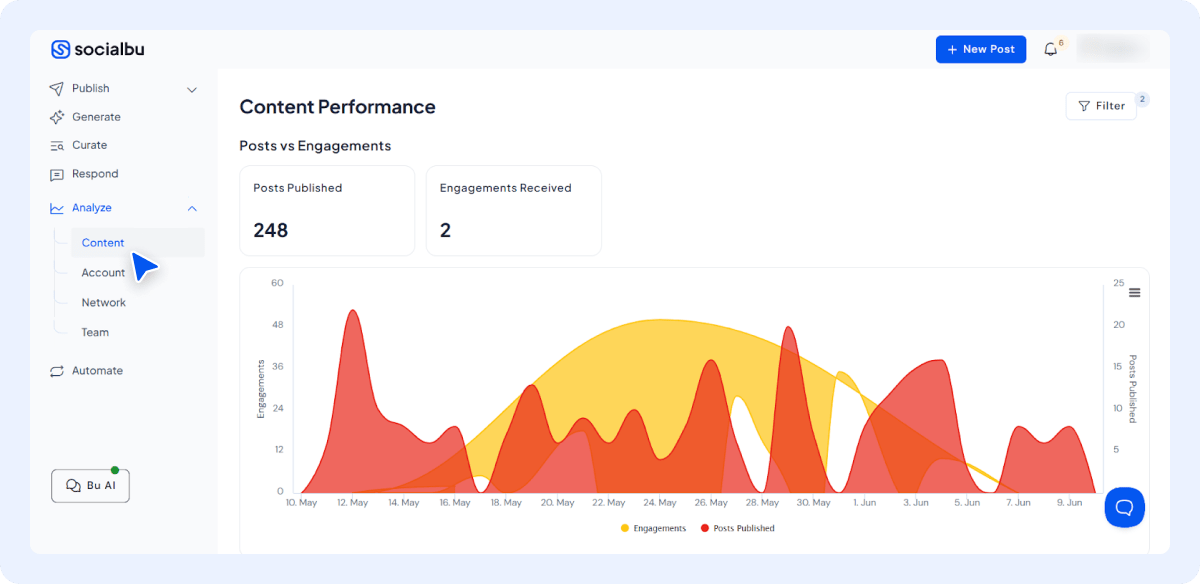
This section displays the performance of your posts across various platforms. You can track:
- Likes, shares, comments, and reach for each post
- Engagement trends by content type (e.g., images, videos, links)
- Top-performing content based on KPIs like impressions or clicks
- Hashtag analysis
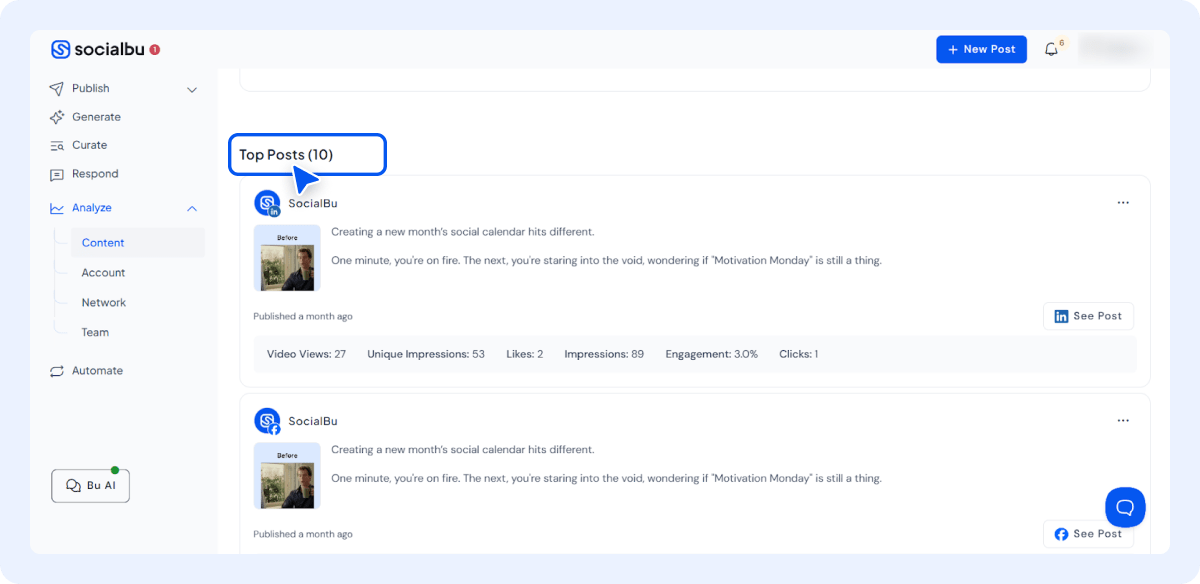
It helps you identify what resonates best with your audience, allowing you to refine your content strategy accordingly.
2. Account Performance

Get a detailed snapshot of how each of your connected social media accounts is performing.
Metrics include:
- Follower growth over time
- Total engagement and reach trends/rate
- Profile visits
- Post frequency
- Account overview
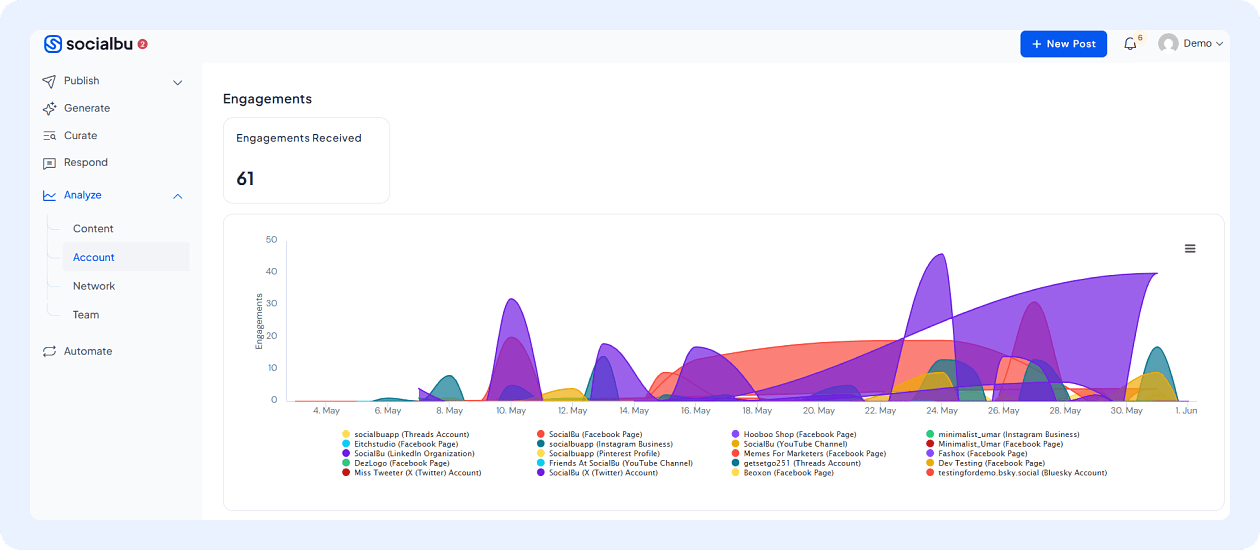
These insights are crucial for assessing your social media presence and monitoring progress toward platform-specific objectives.
3. Network Performance
SocialBu aggregates data across platforms to give you a network-wide overview.
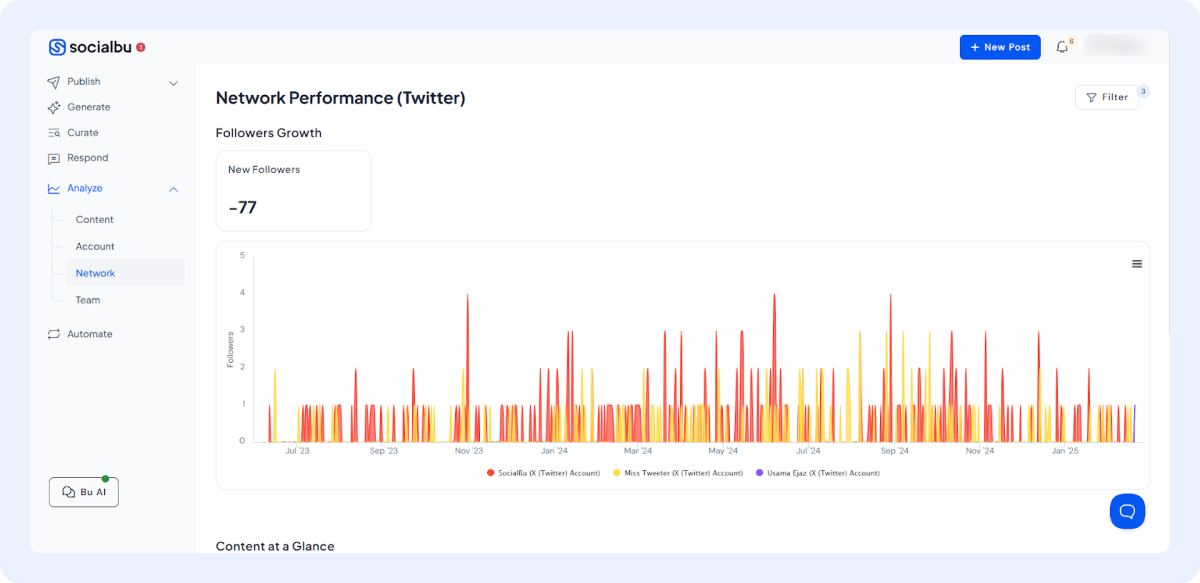
You’ll see:
- Platform-specific insights about performance metrics
- Cross-platform comparisons to spot which networks drive the most value
- Insights into which platform works best for specific campaign goals
This is ideal for agencies managing multiple brands or platforms, helping you optimize your social media strategy across the board.
4. Team Performance

For collaborative teams, this section of the dashboard allows you to evaluate each member’s contribution.
You can track:
- Number of posts scheduled, approved, or published by team members
- Performance of content created or managed by specific individuals
- Workflow efficiency metrics
It ensures accountability, helps identify areas for improvement, and supports smarter team management for agencies and in-house teams alike.
If you’re looking for a platform that simplifies social media data analysis, enhances team workflows, and provides actionable insights, SocialBu is the tool to trust.
Book a demo today and learn how to have a smarter way to manage and measure your social media.
2. Rival IQ
It is another powerful social media analytics platform focused on competitive benchmarking and performance insights. It’s built for marketers who want to stay one step ahead by understanding their content and how their competitors are performing across various platforms.
With Rival IQ, you can track and compare engagement, follower growth, post frequency, and content types across competitors. The platform helps identify industry trends, uncover strategy gaps, and spot opportunities for growth. Its standout feature is competitive analysis, which allows users to set custom watchlists and track dozens of brands in real time.
3. Buffer
Buffer is a renowned social media management tool that offers numerous features. It has its analytics feature for comprehensive social media insights.
It offers clear, visual reports for engagement, reach, impressions, and post performance across Facebook, Instagram, and X (formerly Twitter).
With Buffer, marketers can:
- View content performance trends over time.
- Track top-performing posts and optimal posting times.
- Monitor follower growth and audience behavior.
- Export clean, presentation-ready reports in seconds.
4. Google Analytics
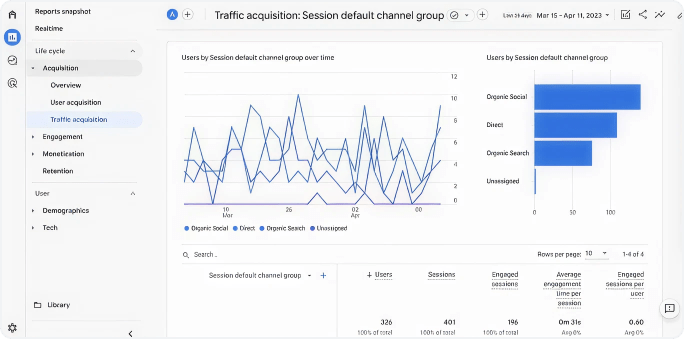
Last but not least, our list includes Google Analytics. Although it is not a dedicated social media analytics tool, it helps marketers and social media experts connect the dots between social efforts and business outcomes.
Using UTM parameters and custom reports, marketers can track:
- Which social platforms drive the most website traffic
- How users from social media interact with the website
- Conversions, bounce rates, and session durations from social channels
- ROI from paid and organic social campaigns
When paired with platform-specific insights, Google Analytics provides a more comprehensive view of social media performance. This data enables teams to tie their strategy to real business metrics and justify future campaigns and budget allocations.
How to Set Up a Social Media Analytics Dashboard
Now, let’s move to the real part – the process of creating a social media analytics dashboard for your social media campaign analysis.
A well-designed social media analytics dashboard gives you a real-time overview of all your metrics in one place. It helps you track performance, extract social media insights, and present clear reports to clients or stakeholders.
Here’s how marketers and agencies can create a meaningful, action-oriented dashboard
Step 1: Set Clear Goals and Objectives
The first step in any social media analytics strategy is to define what you want to achieve.
- Are you looking to increase engagement?
- Improve brand awareness?
- Track ROI from paid campaigns?
- Monitor customer sentiment?
Each goal will determine what you track and how your dashboard is structured.
Examples of goal-aligned KPIs:
- Goal: Grow brand awareness: Track impressions, reach, share of voice.
- Goal: Improve engagement: Track likes, comments, shares, saves.
- Goal: Generate leads: Track clicks, conversions, traffic from social media.
This forms the foundation of your social media measurement process. Use this step to differentiate between vanity metrics (likes) and actionable ones (conversion rate, return on investment).
Step 2: Choose the Right Analytics Tools
Next, select a tool or social media analytics platform that provides the necessary features and easily integrates with all your social media channels.
Look for tools that offer:
- Platform integrations (Facebook, Instagram, LinkedIn, Twitter/X.)
- A customizable analytics dashboard
- Data export and automated visual reporting in the form of charts and graphs
- Competitor and influencer analytics
SocialBu’s Analyze feature is a powerful solution that helps marketers and agencies track everything from a centralized dashboard.
Step 3: Identify the Metrics That Matter
Now that you’ve set your goals and chosen your tool, decide which social media analytics metrics to track. These will vary by use case.
Metrics categories to include:
- Audience analytics: (demographics, follower growth, interests)
- Content performance: (reach, engagement rate, link clicks)
- Paid social analytics: (CTR, CPM, conversions)
- Community management: (response time, sentiment, mentions)
- Social listening: (brand mentions, trends, sentiment analysis)
- Competitor benchmarks: (engagement rate, frequency, reach)
Pro Tip: Avoid overwhelming your dashboard—stick to 10–15 key metrics for clarity and focus. This ensures your dashboard provides real business value, not just vague numbers.
Step 4: Organize and Segment the Data
Effective social media reporting means structuring data in a way that’s easy to analyze, explain, and compare results more effectively.
Segment your dashboard by:
- Platform’s performance (Instagram, LinkedIn, Twitter/X.)
- Campaign type (organic vs paid)
- Date range (weekly, monthly, quarterly)
- Audience or region
This supports social media data analysis at a deeper level, making comparisons more meaningful and insightful.
Step 5: Visualize the Data
A good dashboard makes complex data easy to understand at a glance.
To make your dashboard readable, transform your metrics into visual formats:
- Line and bar charts for growth over time
- Pie charts for audience or content distribution
- Tables for the platform-by-platform breakdown
Visual dashboards facilitate effective communication of performance to clients and the internal team. This enables faster decision-making based on real-time social media tracking.
Pro Tip: Utilize a ready-to-use social media analytics template that you can quickly customize for various clients or campaigns.
Step 6: Monitor, Report, and Refine
Once your dashboard is live, monitor it consistently.
- Schedule regular reporting cycles (weekly/monthly)
- Use social media analytics reporting to share updates with clients/stakeholders
- Identify trends and opportunities using social media intelligence.
- Adjust strategy based on findings (optimize posting times, content types, etc.)
This step ensures continuous social media optimization based on real results.
By following this end-to-end process, marketers and agencies can build a dashboard that not only looks organized but also powers results.
Once your social media analytics dashboard is in place, you’re not limited to just tracking views, likes, and comments. The real power lies in using that data across your entire marketing ecosystem.
You can connect your social media insights with tools like your CRM, email marketing platform, and sales funnel to track a customer’s journey from their first TikTok interaction to conversion.
This integration enables you to create more intelligent segments, send more personalized emails, and automate follow-ups based on real-time user behavior. It transforms your TikTok strategy into a measurable, conversion-focused process that supports your broader business goals and drives long-term growth.
Once your analytics setup is in place, the next question is: Who will manage all this data?
So, you have two options. Depending on your size, goals, and resources, you can hire an expert when things get more complex or start using tools.
| Decision Factor | Hire an Analyst | Use a Tool (like SocialBu) |
|---|---|---|
| Budget | High-cost, ongoing salary & benefits | Cost-effective, subscription-based |
| Team Size | Best for large teams or agencies | Great for small teams, freelancers, or startups |
| Data Complexity | Ideal when you need deep analysis, forecasting, or modeling | Perfect for tracking standard KPIs, content calendars, etc. |
| Speed & Scalability | Slower onboarding requires time to build workflows | Quick setup, scales with your growth |
| Use Case | In-depth performance review, attribution, campaign analysis | Day-to-day post scheduling, automation, and performance tracking |
What KPIs to Track for B2B, B2C, and eCommerce
Not all TikTok strategies are the same, so your KPIs shouldn’t be either. Depending on whether you’re running a B2B, B2C, or e-commerce brand, your performance benchmarks will differ.
Here’s a quick breakdown of the key metrics you should focus on:
| KPI | B2B | B2C | eCommerce |
|---|---|---|---|
| Video Views | Medium priority – awareness-focused | High priority – volume matters | High priority – drives product visibility |
| Engagement Rate | High – to build authority & trust | High – to drive virality | Medium – paired with conversion |
| Click-Through Rate (CTR) | Medium – link to gated assets or demos | High direct response from the audience | Very High – link to product pages |
| Lead Generation/DMs | High guide to funnel/sales team | Medium – community & connection focus | Low – not always a lead-driven goal |
| Conversion Rate | Medium – usually off-platform | Medium – brand goals & offers | High–direct sales or cart actions |
| Follower Growth Rate | Medium – long-term brand building | High social proof & audience loyalty | Medium – builds trust |
| Customer Lifetime Value (CLV) | High–track from TikTok entry point | Medium – depends on industry | High – retargeting TikTok viewers |
Tools like SocialBu make it easier to track platform-specific and goal-specific metrics using custom dashboards tailored for your business type.
Best Practices to Follow for Social Media Analytics
To gain genuine business insights and enhance performance, marketers and agencies must adhere to proven best practices. Here’s how to get the most value from your social media analytics efforts.
Set Clear Goals
Before diving into metrics and dashboards, clearly define your social media goals. Whether you aim to improve brand awareness, increase engagement, or drive website traffic, your objectives will guide every part of the social media analytics process. Goals also determine the specific social media KPIs you’ll measure and how you’ll assess performance.
Goal setting provides structure to your analytics approach, allowing teams to focus on outcomes rather than vanity metrics. Without clear targets, it’s challenging to measure success, optimize performance, or justify marketing decisions to stakeholders.
Choose Relevant Metrics
Once your goals are clear, align them with specific, relevant social media analytics metrics. For example, to boost engagement, focus on metrics such as likes, comments, and shares. If conversions are the priority, track click-through rates, leads, and conversion data from social media platforms.
Avoid tracking every available metric. Instead, focus on those that connect to your strategy and deliver actionable insights. Choosing the right metrics will make your social media analytics dashboard more focused and meaningful.
Track Trends Over Time
Short-term data can provide quick snapshots, but real insights come from long-term tracking. Monitoring your social media performance over weeks and months helps you identify patterns, seasonal behaviors, and campaign impact over time.
Moreover, trend tracking allows marketers and agencies to refine their strategies with greater accuracy. It also supports stronger social media reporting by showcasing consistent growth, successful campaigns, or areas needing attention.
Campaign Optimization with A/B Testing
Testing is essential for campaign improvement. Use A/B testing to compare different content types, post timings, visuals, or call-to-action (CTA) elements. It helps identify what resonates best with your audience and improves content performance based on real-time data.
Social media analytics tools, like SocialBu, make it easy to monitor test results and compare versions side by side. This approach improves your social media ROI by making every campaign more informed and data-backed.
Benchmark Against Competitors
Understanding your own performance is important, but comparing it with industry standards is even better.
Use social media analytics tools that offer competitor analysis and benchmarking capabilities. These allow you to see how your brand stacks up in:
- Engagement rates
- Posting frequency
- Audience growth
- Content performance
SocialBu helps agencies track competitor metrics and surface key insights. Try it now!
Stay Up-to-Date
Social platforms evolve constantly. Algorithm updates, new content formats, or platform features can quickly change what works and what doesn’t. Stay current by following industry updates, reading reliable sources, and using tools that adapt to changes.
Keeping your social media analytics software or platform up to date ensures that your dashboard reflects the latest capabilities. Staying informed helps marketers remain agile and competitive in a fast-paced landscape.
Experiment and Iterate
When you have all the social media analytics reports on your screen, it’s time to make the actual improvements.
Use insights to test new formats, adjust your content mix, or experiment with different engagement strategies. Consistent experimentation helps uncover what works best for your brand and audience.
Treat your analytics as a feedback loop.
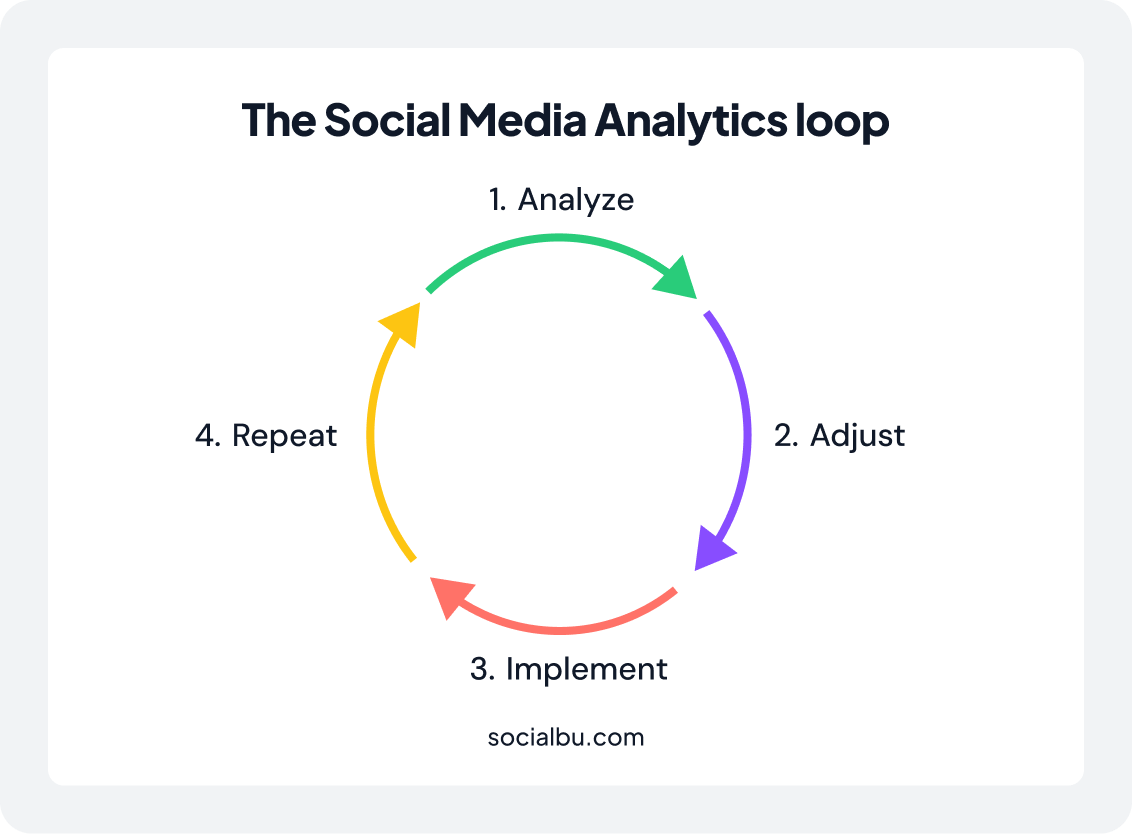
Over time, this practice leads to better-performing content, improved engagement metrics, and more effective campaigns overall.
Ready to Measure Your Social Media Analytics
By now, it’s clear—social media analytics is no longer optional. Whether you’re running campaigns for clients or managing your brand’s online presence, tracking the right data helps you stay focused, strategic, and ahead of the competition.
From understanding audience behavior to optimizing content and proving ROI, analytics offers everything you need to drive smarter decisions and better results. But getting those insights shouldn’t be complicated or time-consuming.
Why? Because SocialBu is here to solve this problem.
Ready to take control of your social media performance? Start using SocialBu now and track, improve, and grow your social media success with confidence with its Analyze feature.
FAQs
What are the Four Types of Social Media Analytics?
The four main types are:
- Descriptive analytics: It explains what happened on social media in the past.
- Diagnostic analytics: It helps understand ‘Why’ it happened.
- Predictive analytics: It forecasts future trends based on past data.
- Prescriptive analytics: It recommends actions to improve future performance.
Together, they provide a complete picture for smarter social media decision-making.
What is the Best Social Media Analytics Tool?
The best tool depends on your needs, but SocialBu stands out for its user-friendly interface, affordability, and powerful features. It offers scheduling, a unified inbox, performance tracking, sentiment analysis, and competitor monitoring—all in one dashboard.
What is the Main Purpose of a Social Media Analytics Tool?
The primary purpose is to track, measure, and analyze social media performance. All this data helps you make informed decisions, optimize campaigns, and prove ROI to clients or stakeholders.
Is Google Analytics Free?
Google Analytics (GA) is available in both free and paid versions, known as Google Analytics 360 (GA360). It helps you track website traffic, including referrals from social media.
